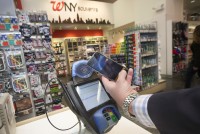If you ask consultants what’s holding back mobile payments in the United States, you’ll get answers ranging from lack of acceptance ubiquity to malfunctions at the point of sale to consumers’ perceptions that payment cards work just fine. Now the nation’s financial institutions have weighed in on the matter, and their answer is: their own and consumers’ security fears.
Fifty-one percent of banks and credit unions cite security concerns as a “high” barrier to consumer adoption, according to a report released Friday by the Federal Reserve Bank of Boston. Another 35% rate these concerns as a “medium” barrier, and only 14% call them a “low” barrier. No other barrier rates are as high in the survey, which consolidates results gathered in 2016 from 706 financial institutions across seven Fed districts. Some 450 of these institutions responded to the question about adoption barriers.

Another “high” barrier, cited by 44% of responding institutions, is “low merchant acceptance/lack of merchant interest.” Another 44% rate this as a “medium” barrier.
Not surprisingly, the survey that forms the basis of the Boston Fed’s “2016 Mobile Banking and Payment Practices of U.S. Financial Institutions” report found consumer adoption and usage rates lagging. Some 211 institutions said they offer mobile payments, and of these 144 track enrollment, while 131 track usage. Eighty-one percent of those that track the matter report an enrollment rate of less than 5% of the customer base. Just 1% say the rate ranges from 35% to 50%. For usage, the percentages are the same.
“Given some of the challenges related to security and merchant acceptance, customer enrollment is growing at a slow rate,” says the report.
What’s at the bottom of these challenges? Much has to do with a crucial difference between mobile payments and its close cousin, mobile banking. Banks and credit unions “directly manage and control access to their mobile- banking services, but mobile payments can be offered by third parties independent of the [financial institution] (e.g., merchant and wallet provider mobile apps) and involve multiple parties in the transaction process,” the report says. “Therefore, there are more points of vulnerability and less standardization of mobile-payment functions and processes.”
The most prevalent security concern for financial institutions is “inadequate customer security behavior,” with 64% of 450 respondents rating it a “high” concern. Coming a close second, at 63%, is “card-not-present fraud.”
As a result, the horizon for mass adoption of mobile payments continues to recede. Among all 706 responding institutions, 80% said it will take anywhere from three to five years for the service to achieve “industrywide consumer adoption” at the point of sale. For in-app and mobile Web usage, 75% cite the same time span.
For now, Apple Pay enjoys a wide lead among the 388 banks and credit unions that say they already offer or plan to offer mobile payments, with 46% currently offering Apple Inc.’s wallet, and another 53% saying they plan to. For rival “Pays” Android Pay, from Alphabet Inc.’s Google unit, and Samsung Pay, from Samsung Electronics Co. Ltd., the corresponding percentages are 22%/52% and 21%/49%, respectively.
Lagging well behind are Visa Checkout (12%/13%), Mastercard Inc.’s Masterpass (4%/13%), Microsoft Wallet (2%/5%), and AmEx Express Checkout (1%/2%).





